“Collection system” refers to the system of underground pipes and maintenance structures that are used to convey wastewater to a wastewater treatment facility. The use of collection systems has brought dramatic improvements to public health in major cities. Most sewers carry wastes from households and commercial establishments and are referred to as sanitary sewers
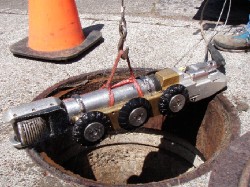 Sanitary Sewer Maintenance
Sanitary Sewer Maintenance
The City of Fond du Lac has a maintenance and cleaning program to keep the sanitary sewer system operating efficiently and to minimize the number of calls for service. Each month staff cleans high-maintenance areas. These are problem areas due to excessive grease build-up, flat lines, or roots clogging the lines.
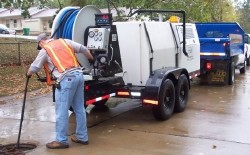 Sewer cleaning using hydraulic or mechanical methods performed on a routine basis helps to remove accumulated debris in the pipe such as sand, silt, grease, roots, and rocks. If debris is allowed to accumulate, it reduces the pipe capacity and a blockage can eventually occur resulting in overflows from the system onto streets, yards, basements, and into surface waters. The City of Fond du Lac has a full-time crew assigned to flushing the sanitary sewer mains.
Sewer cleaning using hydraulic or mechanical methods performed on a routine basis helps to remove accumulated debris in the pipe such as sand, silt, grease, roots, and rocks. If debris is allowed to accumulate, it reduces the pipe capacity and a blockage can eventually occur resulting in overflows from the system onto streets, yards, basements, and into surface waters. The City of Fond du Lac has a full-time crew assigned to flushing the sanitary sewer mains.
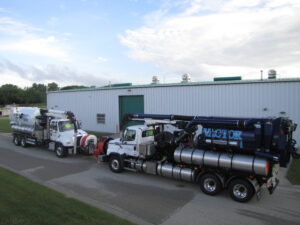 The City of Fond du Lac uses a high-pressure jet-vac truck to clean the sanitary sewer system. High-pressure water is used to propel a jet nozzle at the end of a specialized hose through the sewer pipeline, breaking through obstructions and blockages. A flushing nozzle is installed on the end of the truck’s hose and the hose is lowered into the downstream manhole of the sewer section being cleaned. This method uses high-pressure water to flush out stone, sediment, or other unwanted material from the sewer. As the jet hose is rewound, high-pressure water cleans the sewer walls and back flushes all the debris. The debris is vacuumed out into the truck for proper disposal. The vacuum truck can be used in conjunction with the sewer jet during cleaning operations when the sewer is too deep to clean out the material by hand or when an abundance of material is brought back to the manhole.
The City of Fond du Lac uses a high-pressure jet-vac truck to clean the sanitary sewer system. High-pressure water is used to propel a jet nozzle at the end of a specialized hose through the sewer pipeline, breaking through obstructions and blockages. A flushing nozzle is installed on the end of the truck’s hose and the hose is lowered into the downstream manhole of the sewer section being cleaned. This method uses high-pressure water to flush out stone, sediment, or other unwanted material from the sewer. As the jet hose is rewound, high-pressure water cleans the sewer walls and back flushes all the debris. The debris is vacuumed out into the truck for proper disposal. The vacuum truck can be used in conjunction with the sewer jet during cleaning operations when the sewer is too deep to clean out the material by hand or when an abundance of material is brought back to the manhole.
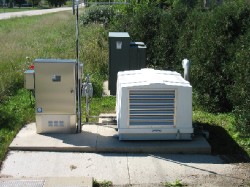 When a downhill grade can’t be maintained, a lift station is installed. A lift station pumps or lifts the waste stream from low-lying areas to higher-lying areas, so gravity can carry the flow to the treatment plant. Some areas must be pumped because gravity flow is not a possibility.
When a downhill grade can’t be maintained, a lift station is installed. A lift station pumps or lifts the waste stream from low-lying areas to higher-lying areas, so gravity can carry the flow to the treatment plant. Some areas must be pumped because gravity flow is not a possibility.
Checks are performed on each station weekly and records are maintained for run time on pumps and for flow calculations. Maintenance procedures and general housekeeping are also performed at each station. Checks are done on backup generators for readiness in case of power outages. For stations without built-in generators staff has portable generators which can be set up to operate the pump station. All of the stations are on a SCADA tracking and alarm system. Computers monitor wet-well levels and pump operation. If a pump fails an alarm is sent for the operator to respond and fix the problem. The system also keeps historical data to be used for reporting purposes.
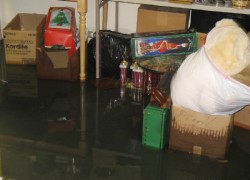 Sewer backup often occurs when stormwater enters the sanitary sewer and causes an overload of water in the system. The overloaded system begins to backflow into household lines, causing sewer water to enter basements. If you’re experiencing backup issues during wet weather, call 920-322-3540 so we can check the sanitary sewer system. We need to know when and where these backups occur so we can analyze the area to determine if we can reasonably reduce future occurrences. During periods of prolonged heavy rainfalls, it is common to experience slower-moving drains until the system catches up.
Sewer backup often occurs when stormwater enters the sanitary sewer and causes an overload of water in the system. The overloaded system begins to backflow into household lines, causing sewer water to enter basements. If you’re experiencing backup issues during wet weather, call 920-322-3540 so we can check the sanitary sewer system. We need to know when and where these backups occur so we can analyze the area to determine if we can reasonably reduce future occurrences. During periods of prolonged heavy rainfalls, it is common to experience slower-moving drains until the system catches up.
